Important stories of historic buildings, people and events pack some places in North Omaha more than any other in the city. From its early role as a commercial outpost on Saunders for a growing city to its explosive realities during the 1960s to the hope it holds for regrowing North O today, one intersection is more important than any other in the community. For decades, everyday people stood on these corners along with leaders, preachers, criminals, protesters, artists and others. Right now, art and commerce, commemoration and social services stand tall. This is a history of the intersection of North 24th and Lake Streets and the surrounding area, referred to now as the 24th and Lake Historic District.
It Started as Saunders Street
The city of Omaha was started in 1854. It was 1872 when “Saunders Street” started showing up on maps of the city and in the newspapers. Named after the last Nebraska Territory governor Alvin Saunders (1817-1899), the street honored him while he was still alive. A pioneer Douglas County judge named George Lake (1827-1910) named the street extending from his property on Sherman Avenue aka North 16th Street after himself.
In those early years of Saunders and Lake Streets, there was a small general store and William Gentleman’s grocery store at the intersection. Nearby was a stable and paddock for horses that belonged to the Omaha Horse Streetcar Company. The rest of the intersection and the surrounding area had small businesses and houses. The settlers were mostly emmigrants from the East Coast, with Scandinavian, German and other north and western European immigrants building the first homes and starting the first businesses in the surrounding neighborhoods.
It was the 1880s when eastern European immigrants began moving into the area. Jews from Germany, Russia, Hungary, Latvia, Lithuania, and other nations established their communities south of the intersection of Saunders and Lake, opening businesses, synagogues and shuls throughout the community.
By 1886, the new Omaha Electric Streetcar terminated at the intersection, leaving shoppers and residents with new stores and services to meet their needs in far north Omaha. By then multiple grocery stores filled the area, and small wooden storefronts were being replaced with large brick buildings from the multiple brick-making plants located at present-day North 30th and Lake. Along with grocery stores, there were at least two hotels, several cafes and taverns, butchers, a haberdashery, junk stores, blacksmiths, and several other businesses at the intersection. There were plans to build an opera house at Saunders and Lake Street in 1887. It was going to seat 600 people with stores on the ground floor and cost $30,000 to build.
That was the beginning of the intersection of North 24th and Lake Streets. In the next few decades, the residential areas around it boomed dramatically. People needed basic services for the times, and businesses burst forth with groceries, undertakers, drug stores and professional offices in demand. The future was coming to 24th and Lake.
Intro to 24th and Lake

Around 1910, the intersection began to reflect the growing presence of African Americans in the neighborhoods to the south. Increasing numbers of African American owned and operated businesses included taverns, blacksmiths, grocers and others. According to the Omaha Bee newspaper, by the 1919 Will Brown riot, the intersection was “the heart of [the] Black Belt” in Omaha. While the mobs were unable to attack the intersection because of US Army soldiers stationed there, the event radically transformed the businesses there as well as the nature of the neighborhoods all around it. This led to the first wave of white flight from the neighborhoods around the intersection as wealthy white people moved away starting immediately after the riot and throughout the course of the next year.

Jazz emerged as the leading cultural force at 24th and Lake in the late 1910s, and after redlining was introduced by the Army, the jazz culture flourished in the commercial district. In addition to multiple theaters and social halls, several other performance spaces opened around the intersection including bars, taverns and dance halls, and during Prohibition, speakeasies.
Big bands were led by Dan Desdunes and others, while smaller outfits emerged to play at the nearby Dreamland Ballroom and in McGill’s Blue Room. The Swingland Club and others were opened by entrepreneurs like Jim Bell and James Jewell. Restaurants and a supper club were opened, and 24th and Lake became home to some of the the most popular jazz destinations in Omaha. Those institutions formed the nexus of North Omaha’s cultural scene for the next four decades, and included businesses like Mildred Brown’s Carnation Ballroom, Paul Allen’s Showcase, the Elks Club, the Off Beat Club, and other places.

During the 1910s, the intersection swelled with business and society and became its most vibrant to that point. Called a “miniature city of Omaha” by the Omaha World-Herald, there were dozens of businesses clustered around the intersection including Carey Cleaners; Dr. P.E. Rasmussen, dentist; the L Garage; the Boston Wet Wash Laundry; Adams-Haight Drug Store; Willis C. Crosby Funeral Home; the Diamond Theater; Nichols Hardware; Lake Hat Shop; Murray’s Furnace and Sheet Metal Shop; and Bunce & Co. Real Estate. There were also grocery stores, a dance hall, social halls, and more.
During that decade, the intersection grew and changed and transformed from being predominantly white and European ethnic immigrants towards having a substantial population of African Americans. Led to the community by the Omaha NAACP, the Omaha Urban League and other advocates, this transformation would change everything. Previously pushed to side streets and alleyways, African American businessmen could do business in the open and solicit white customers. Police would conduct raids around 24th and Lake all the time. However, white politicians in Omaha treated the Black voters who lived around the intersection seriously in several elections. Most importantly by some accounts, a vision for Black upward mobility emerged in Omaha for the first time, right at this intersection.

In 1913, the Easter Sunday tornado struck the intersection with a vengeance, causing damage to dozens of buildings and taking more than 100 lives in the surrounding neighborhoods. In 1919, a white mob lynched an African American man in downtown Omaha and set their sites on the Near North Side, hoping to come up to 24th and Lake. Neither of these incidents defeated the intersection’s importance, but they came close.
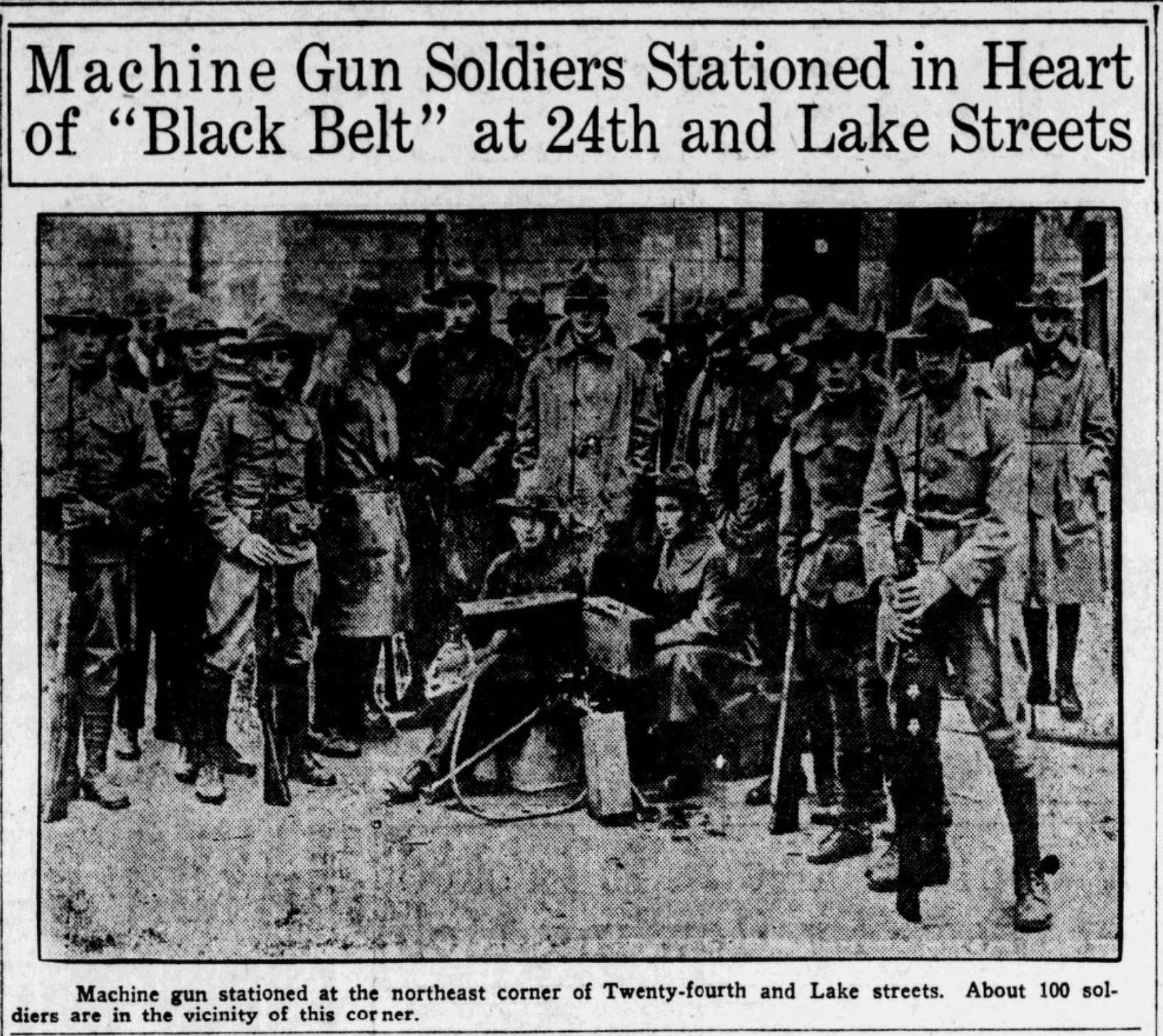
Fifty years after the Easter Sunday tornado, the neighborhoods around the intersection suffered massively from white flight. With gains for African Americans through the Civil Rights movement including desegregated businesses and the formal end of redlining, whites living in the Near North Side, Long School, Lake School and Kountze Place neighborhoods began flooding away from the neighborhood. By the mid-1960s, the intersection of 24th and Lake was pockmarked with empty storefronts and thinned shopping crowds. On a hot July night in 1966, a group of African American youth supposedly began littering the abandoned buildings with rocks and bricks. Over the next three years, dozens of buildings at and around the intersection were looted, firebombed and burned down, changing the entire face of North Omaha.
Throughout the next 20 years, the City of Omaha acted in a punishing way towards the 24th and Lake business district through benign neglect and half-executed renovation programs that never took hold. However, in recognition of the intersection’s role in national history, in 2016 there were 38 buildings included in a new listing on the National Register of Historic Places. This article is an introduction to the powerful, poignant past of a large jewel in North Omaha’s historical crown.
In 2016, 38 buildings were included in a new listing on the National Register of Historic Places called the 24th & Lake Historic District. The following are details about the architecture, events, people and other important details about the past of this historic district.
Jewell Building



The Jewell Building, including the Dreamland Ballroom, at 2221 North 24th Street was built 1923, and was listed on the National Register of Historic Places in 1983. The Dreamland Ballroom ran for more than 40 years, and featured performances by many jazz and blues legends. Some of the performers there included Duke Ellington, Count Basie, Louis Armstrong, Dizzy Gillespie, The Nat King Cole Trio and Lionel Hampton.
Learn more in my article, “A History of the Jewell Building and Dreamland Ballroom” here »
Webster Telephone Exchange Building

The Webster Telephone Exchange Building, the former home of the Great Plains Black History Museum at 2213 Lake Street, was built 1906. Since then, its been home to the Nebraska Telephone Company, the Omaha Urban League Community Center, and the Great Plains Black History Museum, along with several other organizations.
Learn more in my article, “A History of the Webster Telephone Exchange Building” here »
Broomfield Rowhouse

The Broomfield Rowhouse at 2502-2504 Lake Street was built 1913, and originally listed on the National Register of Historic Places in 2007. Jack Broomfield was a shady African American lieutenant for Omaha’s political boss Tom Dennison. Broomfield and Billy Crutchfield hired North Omaha’s architect, “Cap” Clarence Wigington, to design matching duplexes, and Broomfield’s is the only one left. After he died, Dennison said of Broomfield, “He never failed a friend, and about the only enemies he had were those who owed him money.”
Omaha Star Building

The Omaha Star Building at 2216 North 24th Street was built 1923, and originally listed on the National Register of Historic Places in 2007. Architect George Prinz designed Allen Jones’ mortuary in 1923. In 1938, it was bought by Mildred Brown and S. Edward Gilbert, her then-husband, to house their new African American owned, operated and focused newspaper called The Omaha Star. The Omaha Star is the longest operating Black-owned newspaper run by a woman in the United States.
Learn more in my article, “A History of the Omaha Star Newspaper” here »
Micklin Lumber Company

The Micklin Lumber Company Building at 2109 North 24th Street was built early in the 1910s. The building was originally used as a hay dealer, and moved out to let Micklin moved there in 1921. Offering all services related to wood, including planing and more, they moved their business from North 21st and Clark Streets to North 24th Street and stayed there for two decades. In 1941, Micklin moved to their large home improvement facility at North 19th and Izard Streets. The Micklin Lumber Company building on North 24th was used as a planing factory into the 1960s and as a ceramics manufacturer in the 1980s. Today, it is home to Wilson Custom Design Tile.
Skeet’s BBQ
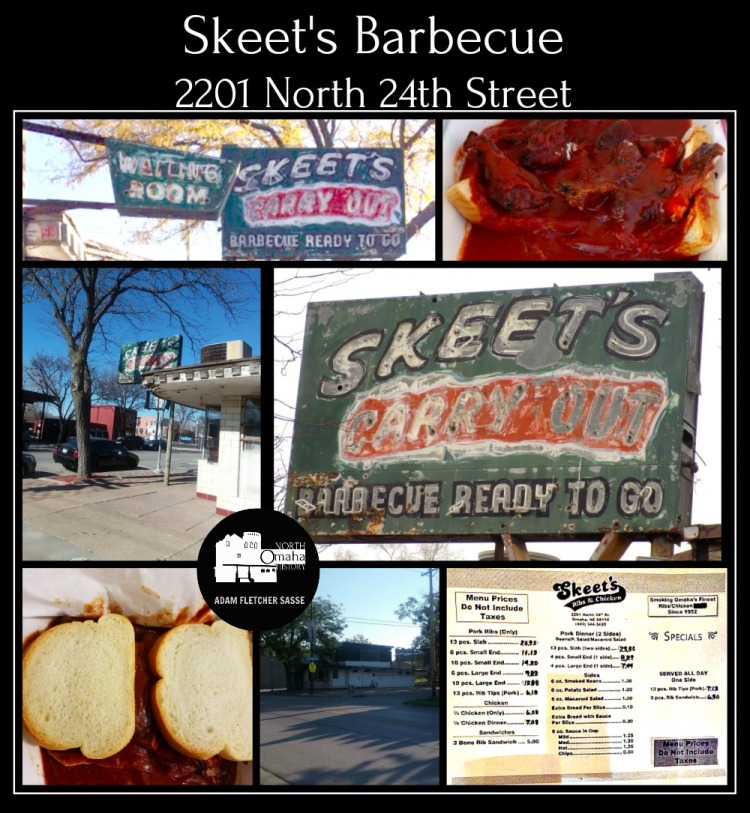
Skeet’s BBQ Ribs and Chicken at 2201 North 24th Street was built around 1955. Harold Whiteside opened Skeet’s that year after becoming a successful businessman. Run by Whiteside’s apprentice David Deal for more than 45 years after he died, Deal passed away in 2019 and the restaurant closed permanently.
Learn more in my article, “A History of Skeet’s Barbecue” here »
United States Post Office Station A
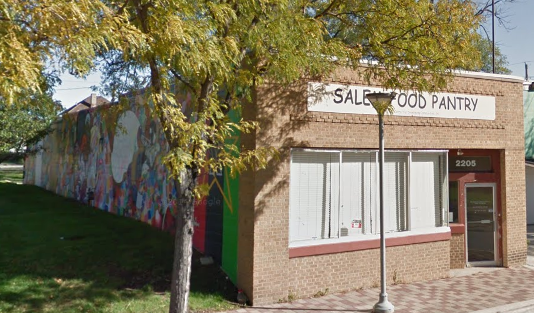
The United States Post Office Station “A” at 2205 North 24th Street was built 1948. Since 1894, there has been a post office near North 24th and Lake Streets. Located on the corner in 1901, it was at North 24th and Erskine during the 1913 Easter Sunday tornado. In the 1940s, the “expanding business in the community” in North Omaha required a new building, and it opened in 1948 at 2205 North 24th Street. It was opened into the early 2000s. It was used by Salem Baptist Church as a food pantry for several years. Today, its home to the spectacular DRIP Coffee Shop.
White Rose Gas Station

The White Rose Gas Station at 2323 North 24th Street was built around 1920. Part of the National Refining Company, also called EN-AR-CO, this was one of at least three White Rose stations in North Omaha. Its classical features include study columns and clear signage areas, and its easy to picture where the pumps were. It was a Mobile station for several decades, and then home to the United Cab Company for a few decades, and has been an automotive garage for a long time since.
Carey Block

The F.J. Carey Block at 2401 North 24th Street was built in 1914. A neighboring building to the massive Edhlom and Sherman Laundry plant, the F.J. Carey Block was originally home to the Carey Cleaners. Edholm and Sherman Laundry moved into the space in the 1940s, staying there until they forced out of business in the 1950s for their racist hiring practices. Automotive body shops operated in it during the 1960s, and Esquire Shining Parlor and Swift Shine Parlor were there in the 1970s. Today it is home to Simple Simon Day Care.
Lion Products Building

The Lion Products Building at 2423 North 24th Street was built in 1918. That year, the building began its life as an automotive garage. The Crosby and Smith Garage, Pep Service Station and New L Garage all occupied the space until 1945. The next year, Lion Products Inc. began selling farm machinery there. Lion left the building in the late 1960s. In the early 1980s, it became part of the renovated The Blue Lion Center. In early 1980s, the building was renovated with its neighbor to become the Blue Lion Building. Designed by an African American-owned architectural firm called Ambrose Jackson Associates, the building opened in 1983. Today, has been redeveloped again to become home to The Union for Contemporary Art.
Learn more in my article “A History of the Blue Lion” here »
Allen’s Showcase

Allen’s Showcase at 2229 Lake Street was built in the late 1930s. A tavern owned by Carl Rabes opened here in 1941, and in 1951, Paul B. Allen, Sr. opened Allen’s Showcase here. Over the years, it became a vital music institution in the community by hosting local, regional and nationally important players. It has been home to several other clubs and restaurants since then.
Learn more in my article, “A History of Allen’s Showcase” here »
26th and Lake Streetcar Shop

The 26th and Lake Streetcar Shop at 2606 North 26th Street was built in 1905. The Omaha and Council Bluffs Street Railway Company was a huge company that employed hundreds of people in North Omaha. They also had more than 100 streetcars that serviced the area, and needed a facility just for them. In 1905, they constructed the facility at North 26th and Lake Streets to do just that. In 1957, when the streetcar company went out of business, the City of Omaha took over the facility. Eventually, it became the Fleet Management Facility where City vehicles were stored and repaired. In 2016, the City began moving out of the facility and in 2018, the building was demolished.
Learn more in my article, “A History of the 26th and Lake Streetcar Barn” here »
Jones and Chiles Building
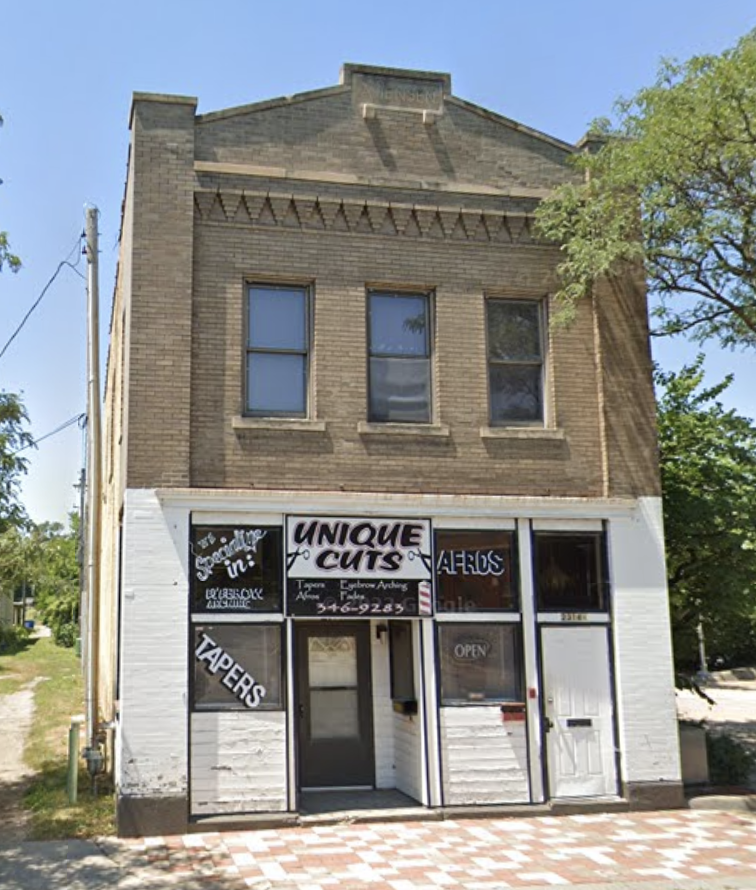
The Jones and Chiles Building at 2314 North 24th Street was built in 1914. In 1916, an African American undertaker named Allen Jones moved into this building. Jones and Reed were morticians here afterwards Chiles left. Herman Friedlander opened a grocery store here by 1926. For the next thirty years either a grocery store or restaurant occupied the first floor. For a short time in the early 1960s, a family doctor named Dr. George B. Lennox had an office on the second floor. Today, the barber shop on the main floor is called Unique Cuts; they are cited across the internet for handing out free condoms.
Learn about the history of 2314 North 24th Street from my article »
Lewis Mortuary

The Joseph D. Lewis Mortuary at 2310 North 24th Street was built around 1926. An African-American, Lewis stayed there until the middle of the 1940s. In the late 1940s, Webster Young and beauty shop owner William King moved in, and by the late 1950s the building was converted to apartments. It has been home to many North Omaha residents since then.
Terrell Drug

Terrell Drugs at 2306 North 24th Street was built in 1914. It was first home to Terrell Drugs, and was used as a drug store from the 1910s into the 1960s. African-American pharmacists E. A. Williamson and Dr. Price Terrell were the first operators, followed by Thomas Ross, Joseph Owen and then Milton Johnson.
Safeway Store

Built in 1963, the former Safeway Store at North 24th and Lake Streets was supposed to be a beacon of business in the neighborhood. After demolishing more than two dozen buildings on the block, the Safeway company built a new store. In 1967, it was targeted by protesters during rioting, and again in 1968. The store closed permanently that year, and the chain left Omaha in the early 1980s. After having several businesses located in it, in 1983 it reopened as the Omaha Small Business Network home that’s today called the Business Technology Center.
Read my article on “A History of Safeway at 24th and Lake” here »
Ideal Hotel
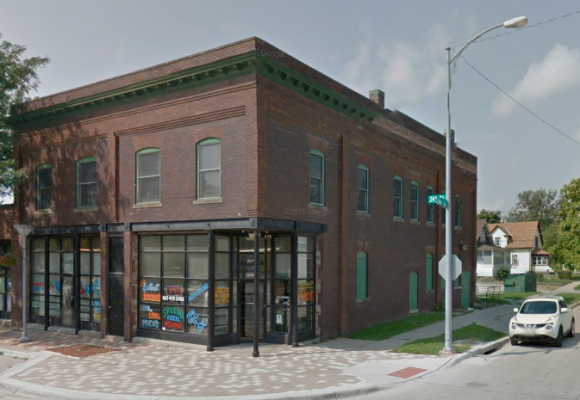
The Ideal Hotel at 2522 North 24th Street was built in 1914. One of the early homes of the USPS Station A, the building has been home to several professionals, including Drs. Paul Rasmussen and Bill Peebles, who were dentists, as well as Dr. Charles Lieber and J. A. Henske. The Ideal Hotel was located here in the 1950s and 1960s. The rest of the building was also home to Ideal Furniture and Hardware, a barber, a billiards hall, and paint stores. Today, its the home of Style of Evolution and several professional offices.
Boston West Laundry

The Boston West Wash Laundry Building at 2414 Lake Street was built around 1913. Today it is home to Big Mama’s Sandwich Shop owned by Patricia “Big Mama” Barron. The longest businesses to stay in the building included Boston West Wash Laundry and the Metz Mansion Cigar Shop. The A&A Music Shop, owned by Paul B. Allan, was there from the 1950s through the 1960s, until they moved to 2508 North 24th Street. In the late 1960s and early 1970s, Muhammad’s Mosque was located there, and then the Family Housing Advisory Services, which became Comprehensive Housing Counseling Agency. Big Mama’s moved in almost a decade ago, and as of fall 2016, is moving out soon.
Elks Club

The Elks Club in the Columbia Hall at 2420 Lake Street was built in 1919. Opened as a social hall for North Omaha’s African American community. It hosted political rallies and was home to the Omaha Colored Commercial Club, which served an as employment bureau that helped hundreds of African American workers get jobs in their new city. The Iroquois Lodge 92 of the black Elks started meeting there in 1929. Today, the Elks Hall continues to host rallies, dances, fundraising meals, and other events.
Learn more in my article “A History of the Elks Club and Iroquois Lodge 92” here »
26th and Lake Garage

The garage at 2526 Lake Street was built in 1946. Car repair shops have been there on and off since it opened, including Bob’s Cleanup Service and Charlie’s Services. Before the 1940s, there was a two story building on this site that had a number of different Black-owned businesses, including barbers, second-hand stores, restaurants and tailors.
Other Important Buildings
The 24th and Lake Historic District was a bustling commercial district for almost 50 years before becoming the African American cultural and economic hub in Omaha. Waves of new residents started building there in the 1870s, long before the city of Omaha had good economic footing. Several wealthy people built country estates in the area around the intersection. Afterward, the area filled in with homes, businesses, churches, synagogues and more.
There are currently other buildings within and right on the perimeters of the 24th and Lake Historic District that are important, too, but didn’t get included on the National Register of Historic Places. Some of them are listed here, and all of the ones included are still standing.
St. Benedict the Moor Catholic Church

In 1921, St. Benedict the Moor Catholic Church was opened as the St. Benedict Community House. Two years later, it was opened as a Black parish at 2423 Grant Street. Since then, the parish has provided a variety of services for the community and held a strong congregation the entire time. Their grade school operated for several decades starting in 1929, and the parish got a new church in the 1950s. Despite suffering the closure of their school, the forced retirement of longtime activist priest Rev. Ken Vavrina, they continue boldly into the future. Today, St. Benedict’s is the only Black Catholic parish in Nebraska.
Learn more from my article “A History of the St. Benedict the Moor Catholic Church” here »
Carnation Ballroom

The Carnation Ballroom is on the northeast corner of North 24th and Miami Streets, and was built in the 1910s. Originally home to the Forbes Bakery, it became the AmVets Club in the 1930s and The Savoy nightclub in the 1940s. In the 1950s, Omaha Star publisher Mildred Brown opened her Carnation Ballroom there. As an alcohol-free all ages venue, the Carnation booked a lot of blues and R&B stars who were little-known artists who later became household names.
Learn more from my article “A History of the Carnation Ballroom” here »
O’Bee Funeral Home
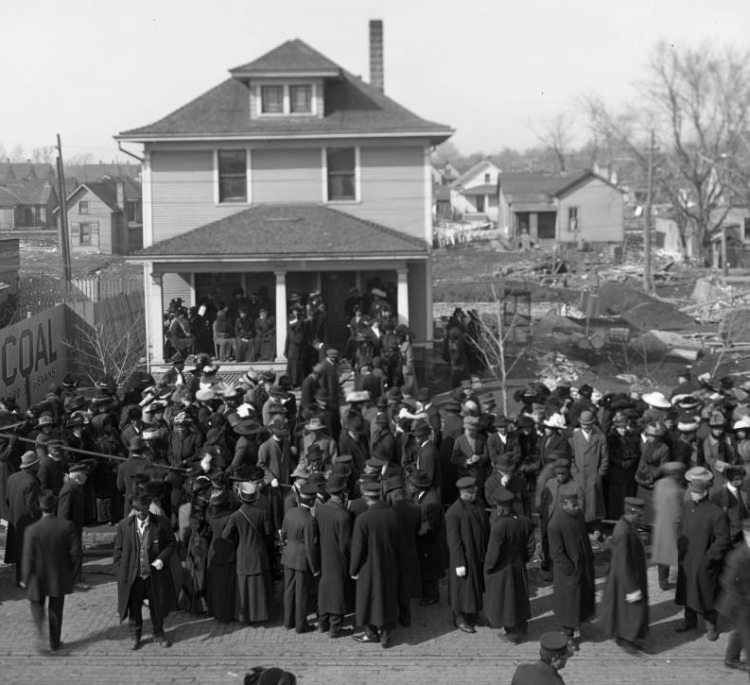
The O’Bee Funeral Home at 2518 Lake Street has an illustrious history in the neighborhood. North Omaha’s architect “Cap” Clarence Wigington designed this house for African American mortician G. Wade Obee as a funeral home in before March 1913. In the picture above, mourners pour in for a funeral after the Easter Day Tornado that year. The Western Undertaking Company moved into the building in 1917, when Obee moved his business to Cuming Street. The first Myers Funeral Home opened here in 1922. Around 1927, Myers moved to 2416 North 22nd Street. After that, the house was then used as a family home, and remains that way today.
Murray the Tinner’s Building was at 2520 North 24th Street was built in 1914. It was home to Ideal Hardward for many years. The Basket Grocery at 2518 North 24th Street was built in 1916. Nesselson’s Grocery was at 2514 North 24th Street, and was built circa 1910. Tomasso’s Restaurant at 2510 North 24th Street was built circa 1916. The Huba Meat Market was at 2506 North 24th Street, and was built circa 1910.
Around the corner, the Carver Savings and Loan Association at 2412 Lake Street was built in 1913. At 24th and Grant, Sig N Archur’s at 2302 North 24th Street was built circa 1959. Harry Frazen’s Confectionary was next door to the Omaha Star Building on the southwest corner of 24th and Grant at 2218 North 24th Street, and was built in 1915. The only houses in the district are the McDonald House at 2225 Lake Street that was built in 1898, and the Paulsen House at 2206 Lake Street was built in 1880. The McDonald House was demolished in 2016.
Buildings Long Gone
There have been many buildings demolished within the 24th and Lake Historic District. As the comparison aerial photos show above, the area is sliver of what it was just 50 years ago. Following is a listing of some of the predominant buildings that have been destroyed.
Fealwell Deli
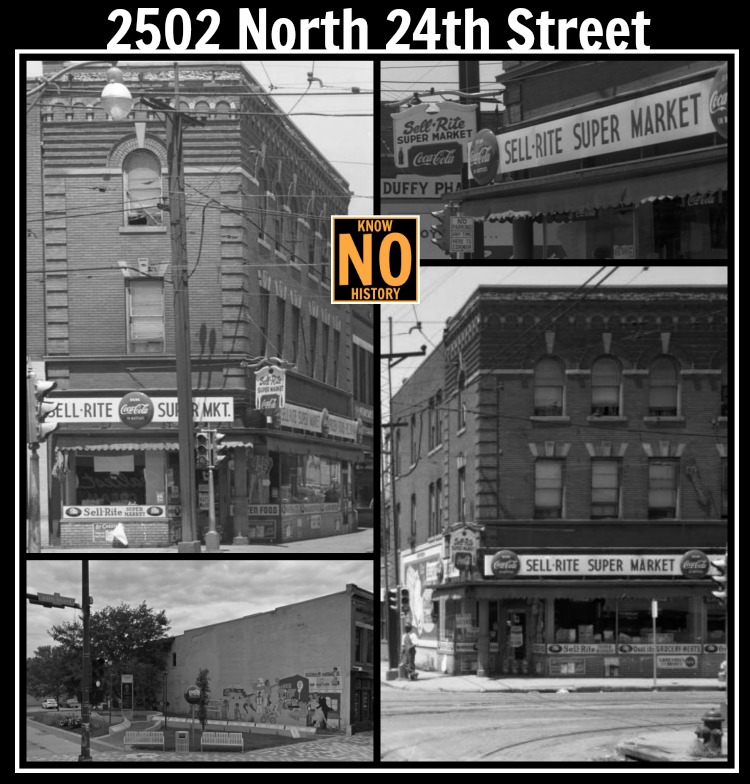
The Feadwell Delicatessen was located at 2502 North 24th Street, on northwest corner, the 1890s and 1910s. A pool hall was located in the back of this building during that same time period. Starting in the 1920s and lasting through the 1940s, there was an optometrist and optical store on the second floor at 2502 North 24th. Tuchman Brothers Grocery was the early corner tenant downstairs, eventually selling their location to become part of the Sell-Rite Market, which also included the storefront at 2504 North 24th. In the 1960s, Thrifty Package Liquor was here. The building was condemned by the City of Omaha after the June 1969 riots, and demolished the following year. Today, this corner is home to the beautiful Rev. Dr. Martin Luther King, Jr. Cornerstone Memorial Plaza, which was finished in 2000.
Duffy Drugs

Duffy Drugs was at 2401 Lake Street on the southwest corner of the 24th and Lake for a long time. Originally built as the two-story Crissey Pharmacy in 1890, the storefront was rebuilt as a single-story after it was obliterated by the 1913 Easter Sunday tornado. The address currently is home to Family Housing Advisory Services, which was only built in 2004. There were several other small storefronts around Duffy Drugs, too.
Learn more in my article “A History of Duffy Drugs” here »
Hart Building

2505 Lake Street was on the northeast corner of the intersection of 24th and Lake. Originally built in 1891 as the two-story William Gentleman Grocery Store, the building was rebuilt after the 1913 Easter Sunday tornado as the Hart Building. While today its home to the Omaha Small Business Network, it was originally a Safeway store that was only built in 1964, and only stayed open for five years. Before that, there was a large two-story building on that corner that is pictured above. There were also at least five other, smaller buildings on the block that were demolished to make room for the Safeway.
Learn about the history of the Hart Building »
Omaha Wet-Wash Laundry

This is the Omaha Wet-Wash Laundry, located at 2519 North 24th Street. The business was open from approximately 1911 through 1925. After they left, Batt’s Grocery Store was there through the 1930s. The Buggy Plumbing and Heating Company opened at the back of this address in 1886. They moved out in 1956. That same year a real estate broker from Lincoln named George Randol moved into the offices here with the intention of building new houses in the Near North Side neighborhood. An introductory article in the Omaha World-Herald said he was working together with the Urban League to ensure Blacks got better housing options. W. W. Cramer had a hardware store in the same building for several years. A two-story building, an African American attorney named Ray L. Williams had offices in the 1950s and 60s. In the early 1960s it was demolished along with the rest of the surrounding block to make room for the new Safeway store, which I explore elsewhere in this article.
Diamond Moving Picture Theatre



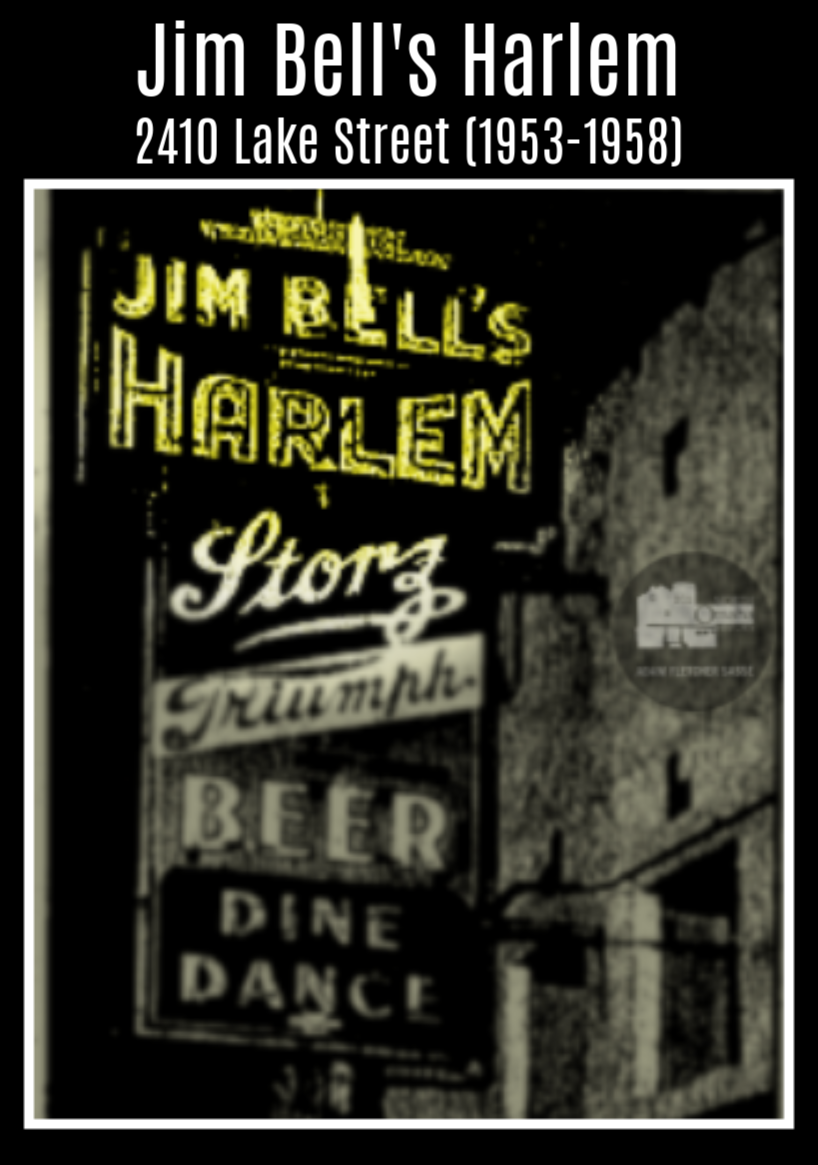
The Diamond Motion Pictures Theatre was important to 24th and Lake for many years. Although its an empty lot now, 2410 Lake Street was been home to many businesses throughout its existence. Starting as the site of the Diamond Theatre in 1911, the original building here was demolished by the Easter Sunday Tornado of 1913. After being rebuilt, the Diamond Motion Picture Company operated the theatre here for approximately another 20 years.
Jim Bell’s Club Harlem opened here around 1935. Learn more in my article “A History of Club Harlem” here »
The Lake Street Bowling Alley opened in the late 1930s, and in 1938 the Swingland Cafe opened here. The Harlem Nites Cafe in 1939. In 1940, the Savoy Cafe was open, and by 1944, the building was home to the Victory Bowling Alley. The Lake Street Theatre was operating here in 1949, and the Lake Street Bowling Alley was here in 1950.
The Off Beat Supper Club was opened here in 1952 and stayed open until 1970.
Learn more in my article “A History of the Off Beat Club” here »
One of the major employers in the area was once the Ash Grove Lime and Portland Cement Company, which was at North 26th and Lake Streets.
Larsen’s Store

According to the Omaha Public Library, this pic shows the interior of Larsen’s Store at North 27th and Lake Streets. Today, this is covered by the North Freeway and there’s no sign the business ever existed.
White Flight

As was said earlier, the 24th and Lake Historic District was brutally punished by white flight. Three distinct waves of white flight wounded the area. They were led by wealthy white people; burnished by middle class white people, and; followed through with poor white people.
The first wave happened between 1919 and 1924. After the September 1919 lynching of Will Brown during the nationwide Red Summer, wealthy white people began pouring out of the area into the perviously established wealthy enclaves of Bemis Park and the Gold Coast, as well as areas further west including Happy Hollow and Fairacres.
During the second wave of white flight between 1939 and 1945, middle class white people completely left the area south of Lake Street between North 24th and North 16th Street. Whites still living in the area didn’t have the economic means to move beyond 60th Street, and largely stayed in place until the mid-1960s. Middle class whites fled from the community because of the construction of the Logan Fontenelle Projects, which greatly depressed the economic value of the neighborhood.
In the next decade, white flight eased in the area south of Lake Street, but accelerated north of Lake Street throughout the Kountze Place neighborhood. The third wave of white flight in North Omaha happened in the early 1950s. Largely seen as undesirable to the predominant middle- and upper-middle class white residents of the neighborhood previously, Kountze Place was specifically abandoned by these people because of its proximity to the Black community to the south. Whites were unable to maintain the race-based covenant that had enforced housing segregation before the 1950s. Most of the mansions and large houses throughout the neighborhood were split into apartment buildings, and the churches were sold to Black congregations looking to move from the Near North Side.
When civil unrest and rioting began in North Omaha in 1966, the fourth wave of white flight began.
Recent History
In the last 15 years, there has been a convergence of resources and energy in rehabilitating the intersection of North 24th and Lake Streets. Learn more in my article “The Recent History of the 24th and Lake Historic District” here »
The North 24th and Lake intersection, now the site of the 24th and Lake Historic District, has been home to many important enterprises that helped shape Omaha’s African American community and all of North Omaha for more than a century. This article is a tribute to all hard work of the women and men who worked to make 24th and Lake a positive, powerful reality for all these years.
You Might Like…
- A History of 24th and Lake Slideshow
- A Tour of the 24th and Lake Historic District
- The Recent History of 24th and Lake
MY ARTICLES ABOUT THE HISTORY OF OMAHA’S NEAR NORTH SIDE
GROUPS: Black People | Jews and African Americans | Jews | Hungarians | Scandinavians | Chinese | Italians
EVENTS: Redlining | North Omaha Riots | Stone Soul Picnic | Native Omaha Days Festival
BUSINESSES: Club Harlem | Dreamland Ballroom | Omaha Star Office | 2621 North 16th Street | Calhoun Hotel | Warden Hotel | Willis Hotel | Broadview Hotel | Carter’s Cafe | Live Wire Cafe | Fair Deal Cafe | Metoyer’s BBQ | Skeet’s | Storz Brewery | 24th Street Dairy Queen | 1324 N. 24th St. | Ritz Theater | Alhambra Theater | 2410 Lake Street | Carver Savings and Loan Association | Blue Lion Center | 9 Center Variety Store | Bali-Hi Lounge
CHURCHES: St. John’s AME Church | Zion Baptist Church | Mt. Moriah Baptist Church | St. Philip Episcopal Church | St. Benedict Catholic Parish | Holy Family Catholic Church | Bethel AME Church | Cleaves Temple CME Church | North 24th Street Worship Center
HOMES: A History of | Logan Fontenelle Housing Projects | The Sherman | The Climmie | Ernie Chambers Court aka Strelow Apartments | Hillcrest Mansion | Governor Saunders Mansion | Memmen Apartments
SCHOOLS: Kellom | Lake | Long | Cass Street | Izard Street | Dodge Street
ORGANIZATIONS: Red Dot Athletic Club | Omaha Colored Baseball League | Omaha Rockets | YMCA | Midwest Athletic Club | Charles Street Bicycle Park | DePorres Club | NWCA | Elks Hall and Iroquois Lodge 92 | American Legion Post #30 | Bryant Resource Center | People’s Hospital | Bryant Center
NEIGHBORHOODS: Long School | Logan Fontenelle Projects | Kellom Heights | Conestoga | 24th and Lake | 20th and Lake | Charles Street Projects
INDIVIDUALS: Edwin Overall | Rev. Russel Taylor | Rev. Anna R. Woodbey | Rev. Dr. John Albert Williams | Rev. John Adams, Sr. | Dr. William W. Peebles | Dr. Craig Morris | Dr. John A. Singleton, DDS | Dr. Aaron M. McMillan | Mildred Brown | Dr. Marguerita Washington | Eugene Skinner | Dr. Matthew O. Ricketts | Helen Mahammitt | Cathy Hughes | Florentine Pinkston | Amos P. Scruggs | Nathaniel Hunter | Bertha Calloway
OTHER: 26th and Lake Streetcar Shop | Webster Telephone Exchange Building | Kellom Pool | Circus Grounds | Ak-Sar-Ben Den
MY ARTICLES ABOUT THE HISTORY OF N. 24TH ST.
NATIONAL REGISTER OF HISTORIC PLACES: 24th and Lake Historic District | Calvin Memorial Presbyterian Church | Carnation Ballroom | Jewell Building | Minne Lusa Historic District | The Omaha Star
NEIGHBORHOODS: Near North Side | Long School | Kellom Heights | Logan Fontenelle Housing Projects | Kountze Place | Saratoga | Miller Park | Minne Lusa
BUSINESSES: 1324 North 24th Street | 24th Street Dairy Queen | 2936 North 24th Street | Jewell Building and Dreamland Ballroom | 3006 Building | Forbes Bakery, Ak-Sar-Ben Bakery, and Royal Bakery | Blue Lion Center | Omaha Star | Hash House | Live Wire Cafe | Metoyer’s BBQ | Fair Deal Cafe | Carter’s Cafe | Carnation Ballroom | Alhambra Theater | Ritz Theater | Suburban Theater | Skeet’s BBQ | Safeway | Bali-Hi Lounge | 9 Center Five-and-Dime
CHURCHES: Calvin Memorial Presbyterian Church | Pearl Memorial United Methodist Church | Immanuel Baptist Church | Mt Moriah Baptist Church | Bethel AME Church | North 24th Street Worship Center
HOUSES: McCreary Mansion | Gruenig Mansion | Redick Mansion
INTERSECTIONS: 24th and Lake | 24th and Pratt | 24th and Ames | 24th and Fort | Recent History of 24th and Lake | Tour of 24th and Lake
EVENTS: 1898 Trans-Mississippi and International Exposition | 1899 Greater America Exposition | 1913 Easter Sunday Tornado | 1919 Lynching and Riot | 1960s Riots
HOSPITALS: Mercy Hospital | Swedish Covenant | Salvation Army
OTHER: Omaha Driving Park | JFK Rec Center | Omaha University | Creighton University | Bryant Center | Jacobs Hall | Joslyn Hall
RELATED: A Street of Dreams | Redlining | Black History in Omaha | North Omaha’s Jewish Community | Binney Street | Wirt Street
MY ARTICLES ABOUT HISTORIC NEIGHBORHOODS IN NORTH OMAHA
National Register of Historic Places Historic Districts in North Omaha: 24th and Lake Historic District | Benson Downtown Historic District | Country Club Historic District | Dundee/Happy Hollow Historic District | Fairacres Historic District | Fort Omaha Historic District | Minne Lusa Historic District | Nicholas Street Historic District
Historic Neighborhoods in North Omaha: Bedford Place | Belvedere Point | Bemis Park | Benson | Briggs | Bungalow City | Carter Lake, Iowa | Central Park | Clifton Hill | Collier Place | Creighton University | Crown Point | DeBolt | Druid Hill | East Omaha | Fairfax | Florence | Florence Field | Fort Omaha | Fontenelle View | Gifford Park | Gold Coast (Cathedral) | High Point | Jefferson Square | Kellom Heights | Kountze Place | Lakewood Gardens | Little Russia | Long School | Malcolm X Memorial | Miller Park | Miller Park Duplex Historic District | Monmouth Park | Montclair | Near North Side | North Downtown Omaha | Omaha View | Orchard Hill | Plum Nelly | Prettiest Mile in Omaha | Prospect Place | Raven Oaks | Redman | Saratoga | Sherman | Squatter’s Row | Sulphur Springs | Ponca Hills | Wakonda | Walnut Hill | Winspear Triangle | Wyman Heights
Lost Towns in North Omaha: Benson | Briggs | DeBolt | East Omaha | Florence | Saratoga | Sulphur Springs
MY ARTICLES ABOUT THE HISTORY OF MUSIC IN NORTH OMAHA
PEOPLE: George T. McPherson | Dan Desdunes | Flora Pinkston | Jimmy Jewell, Sr. and Jimmy Jewell, Jr. | Jim Bell | Paul Allen, Sr. | Josiah “P.J.” Waddle | Frank “Red” Perkins | George Bryant
PLACES: 24th and Lake Historic District | Dreamland Ballroom | Carnation Ballroom | Stage II Lounge | Club Harlem | The Off Beat Club | King Solomon’s Mines | Allen’s Showcase | Druid Hall
EVENTS: Stone Soul Picnic | Emancipation Day & Juneteenth | Native Omahans Festival
MY ARTICLES ABOUT THE HISTORY OF STREETS IN NORTH OMAHA
STREETS: 16th Street | 24th Street | Cuming Street | Military Avenue | Saddle Creek Road | Florence Main Street
BOULEVARDS: Florence Boulevard | Fontenelle Boulevard
INTERSECTIONS: 42nd and Redman | 40th and Ames | 40th and Hamilton | 30th and Ames | 24th and Fort | 30th and Fort | 24th and Ames | 24th and Lake | 16th and Locust | 20th and Lake | 45th and Military | 24th and Pratt
STREETCARS: Streetcars | Streetcars in Benson | 26th and Lake Streetcar Barn | 19th and Nicholas Streetcar Barn | Omaha Horse Railway
BRIDGES: Locust Street Viaduct | Nicholas Street Viaduct | Mormon Bridge | Ames Avenue Bridge | Miller Park Bridges
OTHER: North Freeway | Sorenson Parkway | J.J. Pershing Drive | River Drive
Elsewhere Online
- “North 24th Street Walking Tour” by Restoration Exchange Omaha
- “24th and Lake Historic District application,” National Register of Historic Places
BONUS PICS!
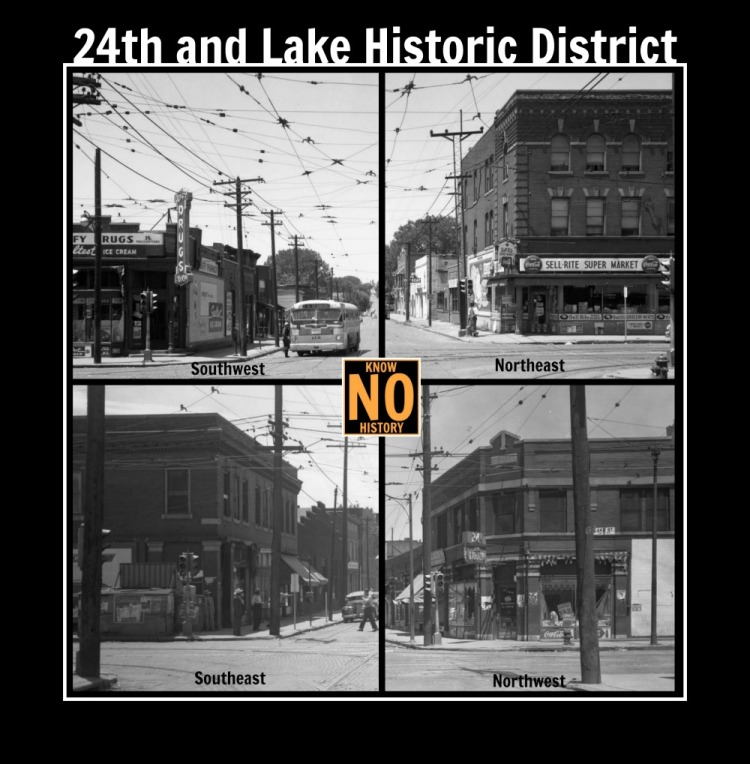

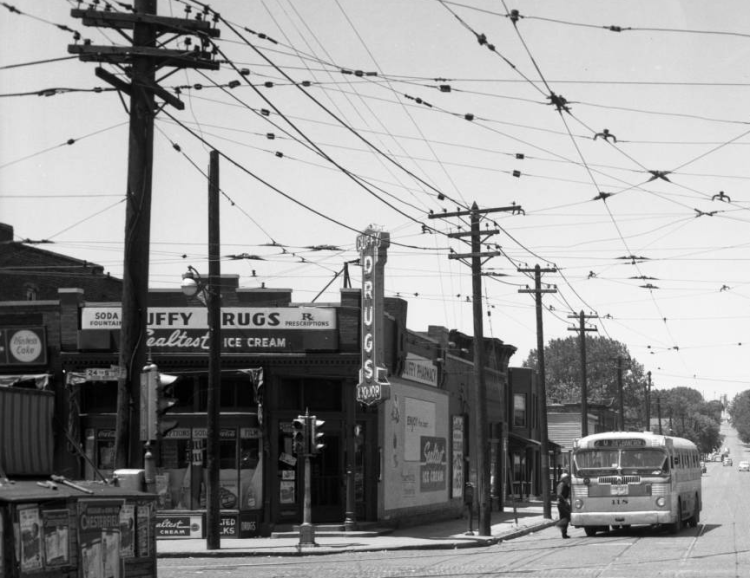



Drawings of 24th and Lake Buildings by Adam Fletcher Sasse for NorthOmahaHistory.com



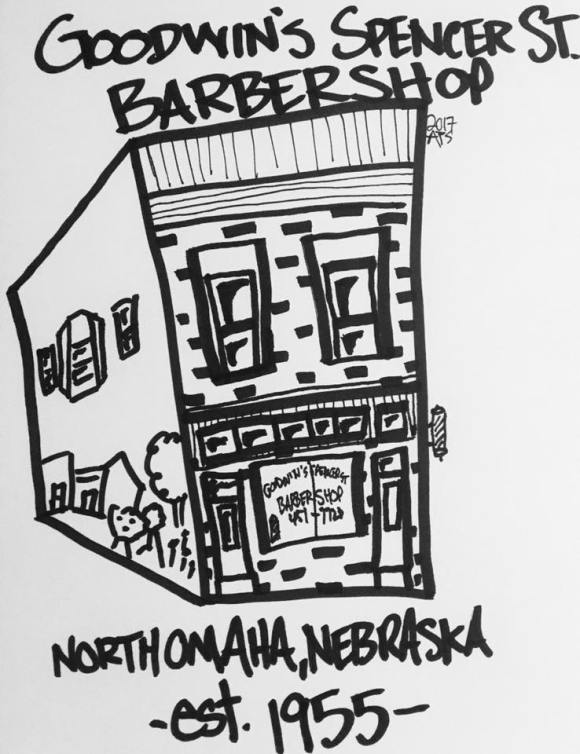








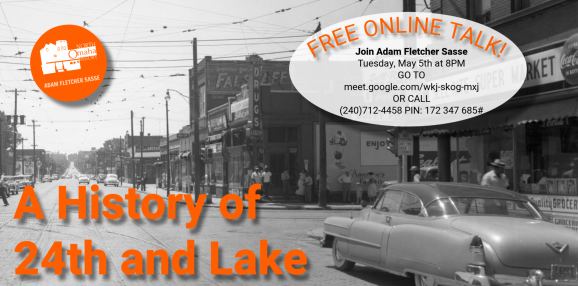


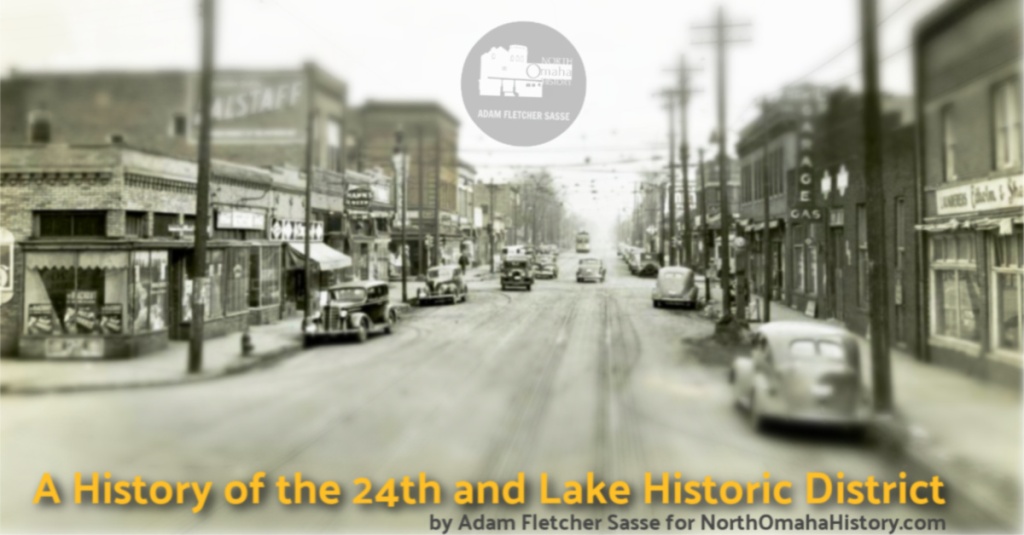
Leave a comment